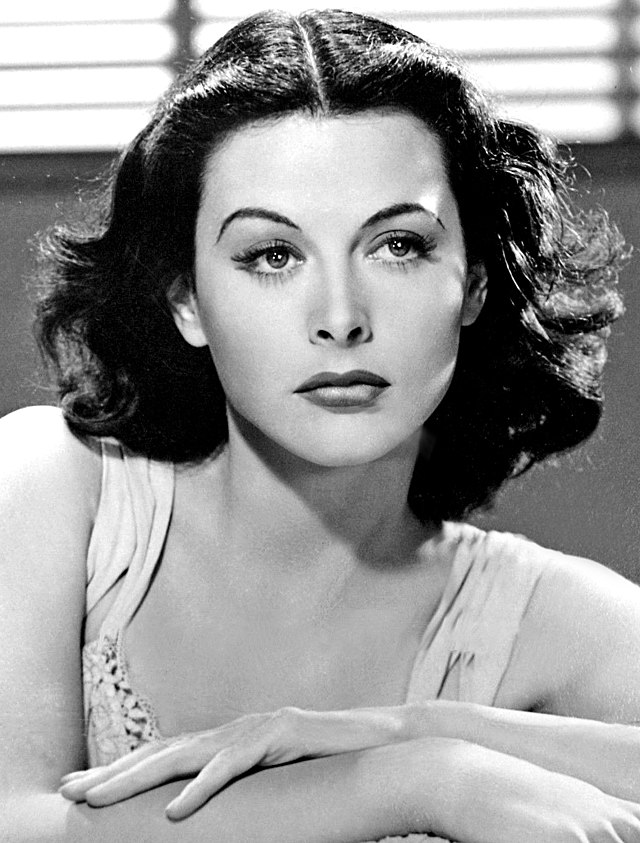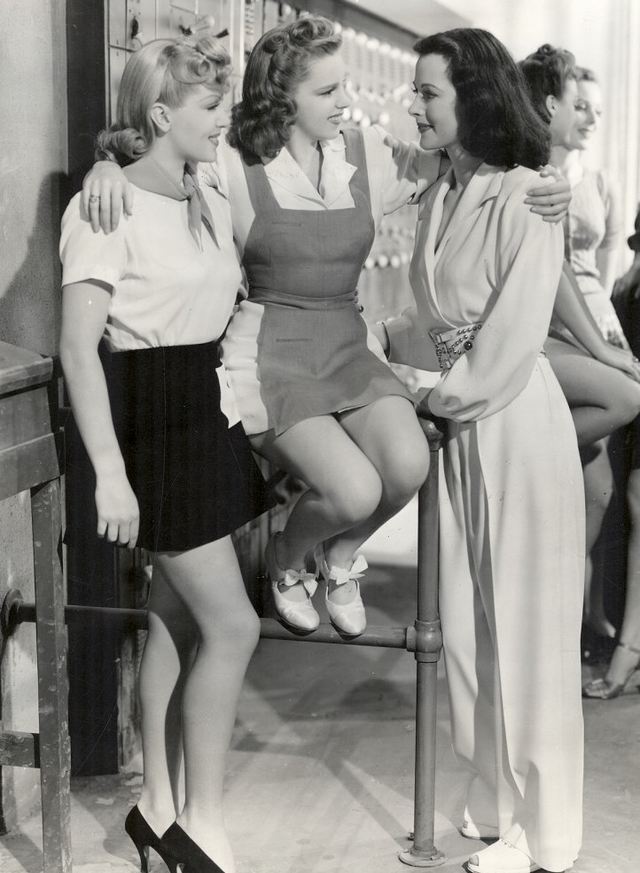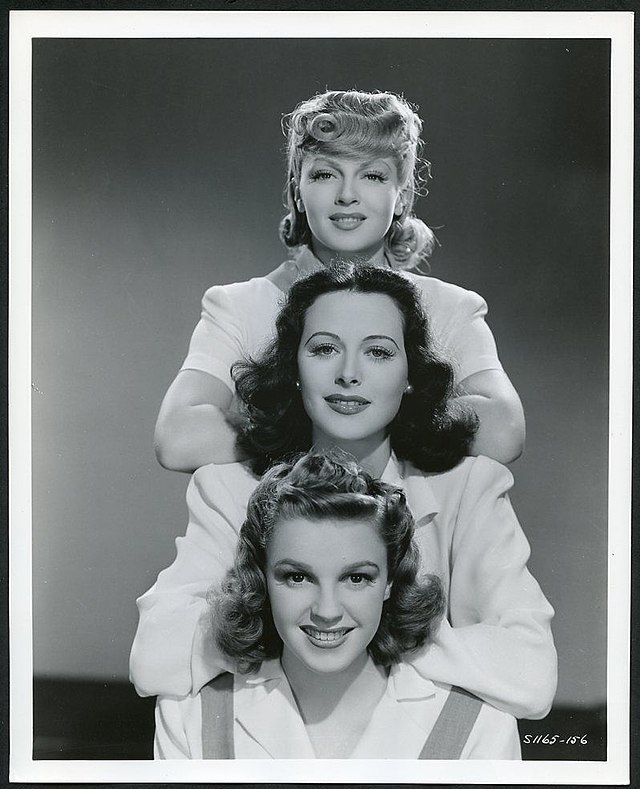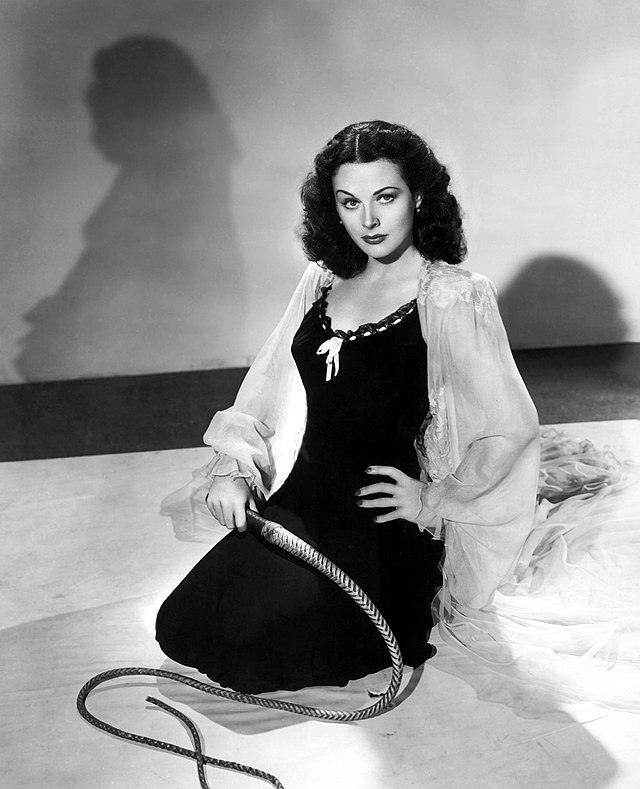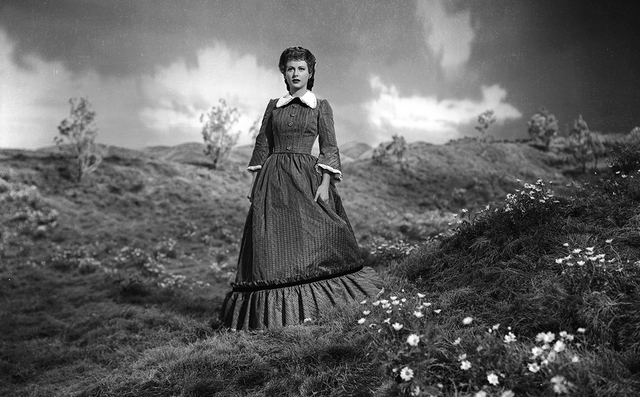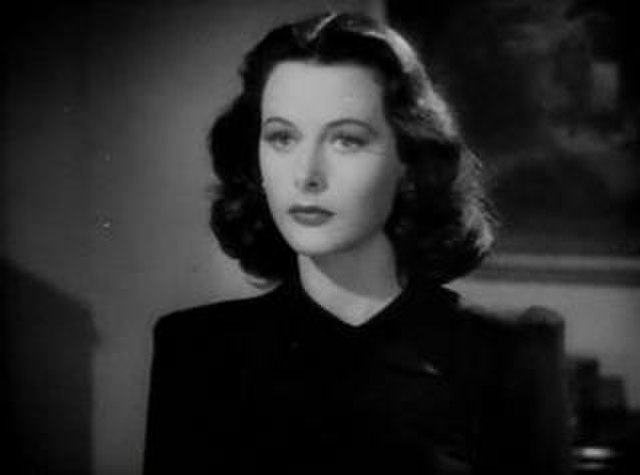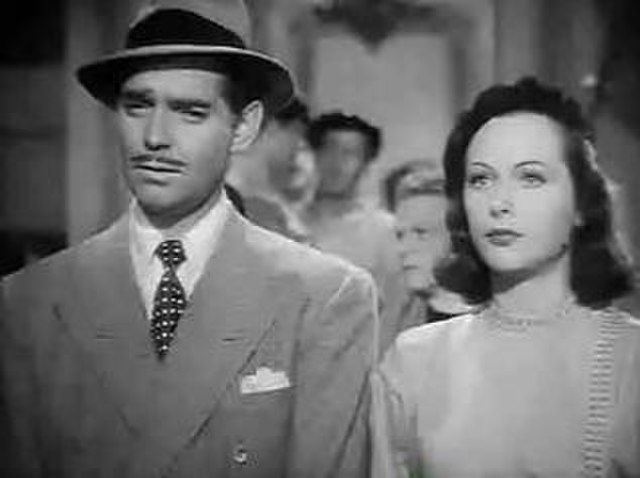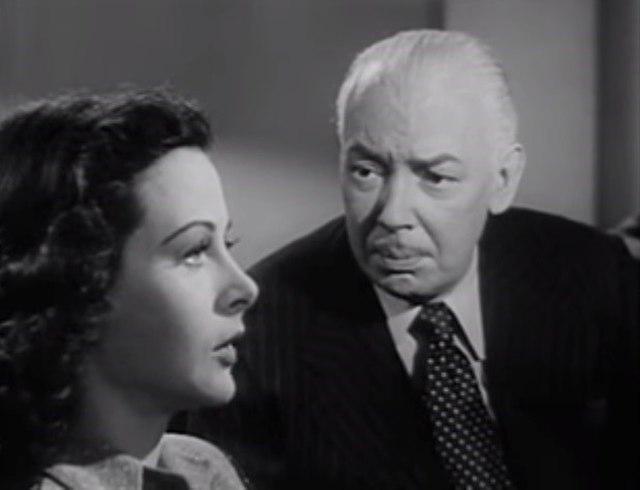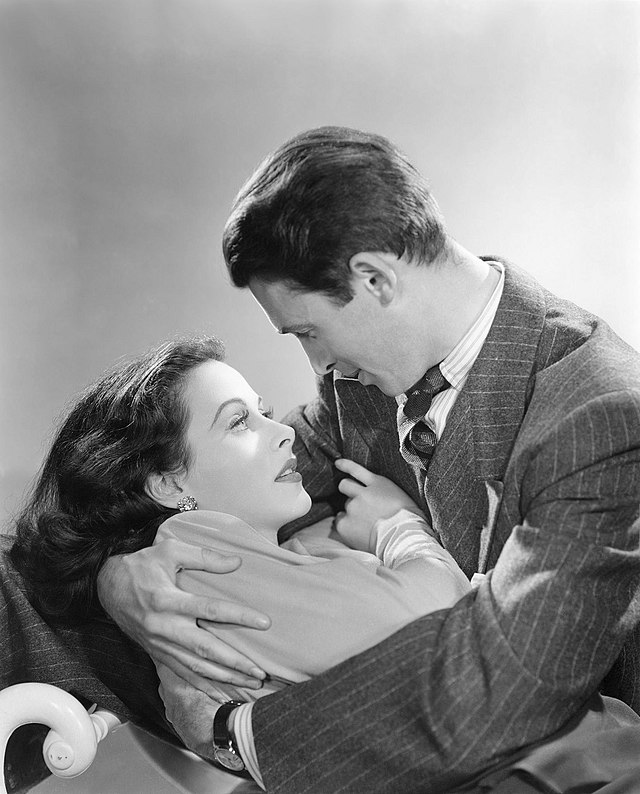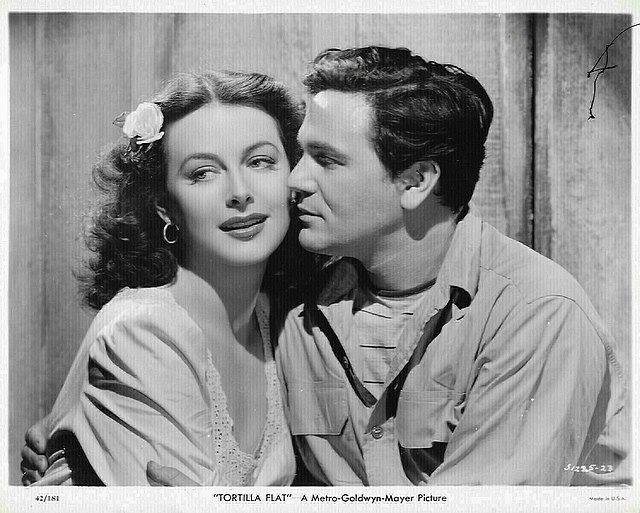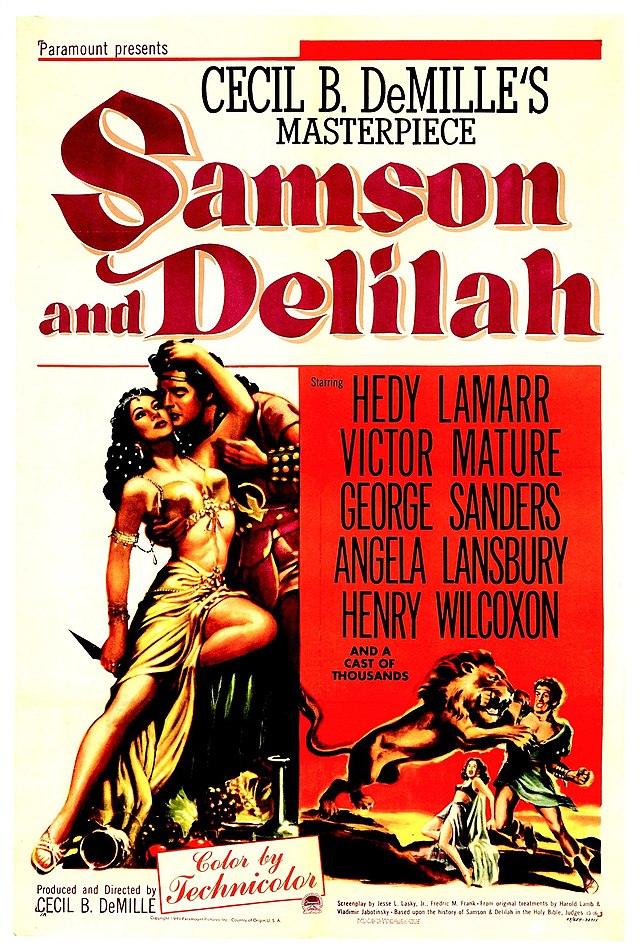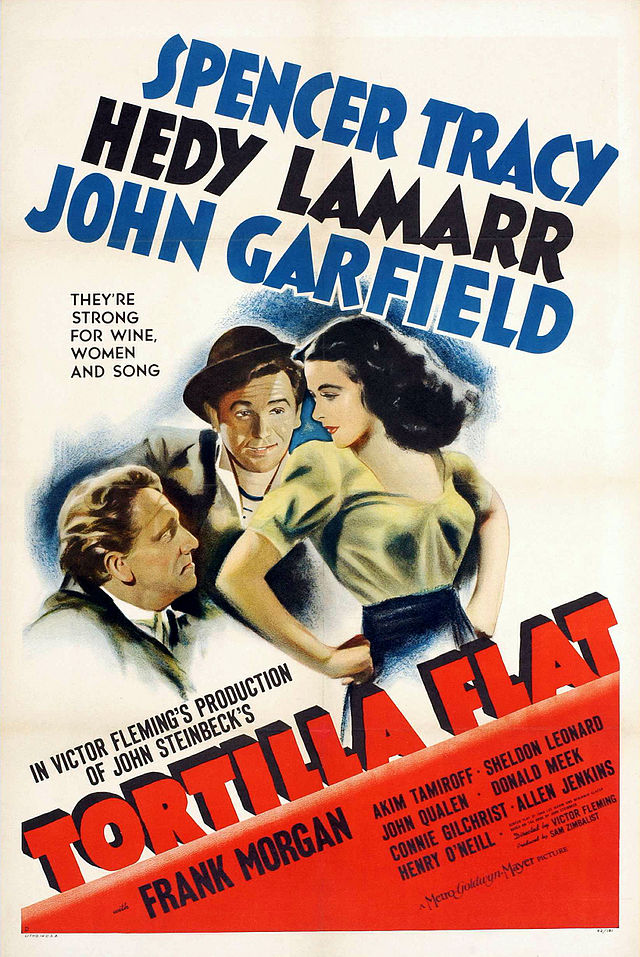Hedy Lamarr
back| Full Name | Hedwig Eva Maria Kiesler |
| Stage Name | Hedy Lamarr |
| Born | November 9, 1914 |
| Birthplace | Vienna, Austria-Hungary (now Austria) |
| Died | January 19, 2000 |
| Buried | Ashes were spread in the Vienna Woods (per her request, though her children kept some of her ashes) |
| Married to | Fritz Mandl (1933–1937) - Gene Markey (1939–1941) - John Loder (1943–1947) - Ernest |
| Children | James Loder (adopted son) - Denise Loder - Anthony Loder |
| Notable films | Ecstacy (1933) - Algiers (1938) - Boom Town (1940) - Samson and Delilah (1949) - Tortilla Flat (1942) |
Hedy Lamarr
The Most Beautiful Woman in the World
Hedy Lamarr (1914–2000) was a renowned Austrian-American actress and inventor. Born in Vienna, she became famous in Europe with the controversial film Ecstasy (1933) before fleeing an oppressive marriage and moving to Hollywood. There, she starred in films like Algiers (1938), Samson and Delilah (1949), and Boom Town (1940), earning a reputation as one of the most beautiful women in the world.
However, Lamarr was also a brilliant inventor. During World War II, she co-invented a frequency-hopping system with composer George Antheil to prevent the jamming of Allied torpedoes.
Related
Hedy Lamarr (1914 – 2000)
Biography and Movie Career
Hedy Lamarr, born Hedwig Eva Maria Kiesler on November 9, 1914, in Vienna, Austria-Hungary, was the only child of a wealthy Jewish family. Her mother, Gertrud Lichtwitz, was a concert pianist of Hungarian descent, and her father, Emil Kiesler, was a successful banker with a deep interest in technology. Hedy was raised in a cultured environment, exposed to the arts, music, and science from a young age. She quickly developed a love for acting and theater, captivating audiences even as a young girl with her beauty and charm.
Early Life and Path to Success
As a teenager, Lamarr’s striking appearance made her a natural fit for the screen, and she was discovered by director Max Reinhardt, who cast her in small roles in Austrian films. At the age of 18, she starred in the film Ecstasy (1933), which brought her international attention, albeit controversially. The movie featured brief nude scenes, making Lamarr one of the first actresses to be depicted this way in cinema. Although it was a European art film, Ecstasy caused a sensation and was banned in several countries, including the United States.
Her beauty captivated powerful admirers, including Austrian arms manufacturer Fritz Mandl, who courted and married her in 1933. Mandl, controlling and possessive, tried to buy up all copies of Ecstasy to protect Lamarr's image. Their marriage, marked by Mandl’s jealousy and his close ties to fascist regimes, became stifling. Hedy later described the marriage as being like a prison, with Mandl even restricting her from acting. This oppression only fueled her desire to escape, and in 1937, Lamarr fled Austria, first to Paris and then to London, where her life would take a dramatic turn.
Hollywood Stardom
While in London, Lamarr met MGM studio head Louis B. Mayer, who was immediately struck by her beauty and offered her a contract, though he insisted she change her name to "Hedy Lamarr" to distance herself from her previous scandalous role in Ecstasy. Mayer brought her to Hollywood, where she made her American film debut in Algiers (1938), opposite Charles Boyer. Her role as the exotic, mysterious woman captured the imaginations of audiences and established her as one of the most beautiful women in the world.
Throughout the 1940s, Lamarr starred in numerous films, often cast as a glamorous seductress. Some of her most notable films from this period include Boom Town (1940), alongside Clark Gable and Spencer Tracy; Ziegfeld Girl (1941), co-starring Judy Garland and Lana Turner; and Samson and Delilah (1949), a biblical epic directed by Cecil B. DeMille, in which she played one of her most famous roles, the treacherous Delilah. This film was a huge box-office success and solidified her place as one of Hollywood’s top stars.
Passion for Invention
Though she was celebrated for her beauty, Lamarr was far more than just a screen goddess. Her intellectual curiosity, fostered in part by her father’s interest in technology, remained a significant part of her life. During World War II, disturbed by the news of the sinking of passenger ships by German U-boats, Lamarr began to focus on using her knowledge to help the war effort. She teamed up with composer and inventor George Antheil, and together they developed a groundbreaking frequency-hopping communication system. The idea was to allow radio-controlled torpedoes to switch frequencies in such a way that they could avoid being detected or jammed by enemy forces.
In 1942, they were granted a patent for their invention, which would later become the foundation for modern wireless communication technologies like Wi-Fi, Bluetooth, and GPS. However, at the time, the U.S. Navy did not adopt the technology for use during the war, and it wasn’t until decades later that Lamarr’s invention was fully appreciated. She received little to no recognition during her lifetime for her contributions to science, though she would later be celebrated as a pioneer in telecommunications.
Personal Life and Marriages
Lamarr’s personal life was as dramatic and tumultuous as her film career. She was married six times:
- Fritz Mandl (1933–1937): Her first marriage, to Austrian munitions magnate Fritz Mandl, was controlling and abusive, leading to her eventual escape.
- Gene Markey (1939–1941): Her second husband was a screenwriter and producer. They adopted a son, James, but their marriage quickly fell apart due to Markey’s infidelity.
- John Loder (1943–1947): Loder, a British actor, was Lamarr's third husband and the father of her two biological children, Denise and Anthony. Despite having children together, their marriage was troubled, and they divorced after four years.
- Ernest “Ted” Stauffer (1951–1952): Stauffer, a nightclub owner and restaurateur, was her fourth husband, though their marriage lasted less than a year.
- W. Howard Lee (1953–1960): Her fifth marriage, to Texas oilman Howard Lee, lasted the longest. Lamarr moved to Houston during this time, but the couple eventually divorced after Lee began an affair with actress Gene Tierney.
- Lewis J. Boies (1963–1965): Boies, her sixth and final husband, was a lawyer. Their marriage, too, ended in divorce after only two years.
Hedy’s romantic life was marked by drama, betrayal, and a longing for stability, which she never seemed to find. She once quipped that although she knew a great deal about love on-screen, it eluded her in real life.
Later Years and Death
In her later years, Lamarr grew more reclusive. She retired from acting in the late 1950s, though she made occasional public appearances throughout the 1960s and 1970s. However, her later life was marred by legal troubles, including several arrests for shoplifting, and a series of plastic surgeries that left her unrecognizable from her former glamorous self. She also battled health issues and spent much of her time in isolation, communicating with friends and family primarily by telephone.
Despite her reclusiveness, Lamarr’s scientific achievements finally began to receive recognition in the 1990s. In 1997, she and George Antheil were honored with the Electronic Frontier Foundation Pioneer Award for their frequency-hopping technology. She was also posthumously inducted into the National Inventors Hall of Fame in 2014, securing her legacy as not only a screen legend but also an influential inventor.
Hedy Lamarr died on January 19, 2000, at the age of 85 in her home in Casselberry, Florida. The cause of death was heart disease. In accordance with her wishes, her ashes were scattered in the Vienna Woods, close to her childhood home, a symbolic return to the country she had fled so many years before.
Legacy
Lamarr’s life was a paradox: celebrated for her physical beauty while her intellectual brilliance went largely unnoticed during her lifetime. Today, she is remembered not only as one of the most glamorous stars of Hollywood’s Golden Age but also as a visionary inventor whose contributions to science were decades ahead of her time. Her dual legacy as both a film star and a technological innovator continues to fascinate and inspire.
Hedy Lamarr Story: From Actress to Scientist
Understated Acting Style of Hedy Lamarr
Hedy Lamarr’s acting style was defined by a rare combination of beauty, elegance, and an enigmatic screen presence, which made her one of the most captivating stars of Hollywood’s Golden Age. While her extraordinary looks initially drew audiences in, her ability to express complex emotions subtly and effectively allowed her to take on a wide range of roles, from femme fatales to misunderstood heroines.
Understated Sophistication
Lamarr’s performances were often marked by a refined, almost regal, grace. Her gestures were controlled, deliberate, and elegant, which gave her characters an aura of sophistication. She often played characters who were mysterious or aloof, and she communicated this through a calm, composed demeanor that contrasted with the more animated styles of other actresses of her time. Her quiet confidence on screen gave her characters an air of intelligence and complexity, even when the scripts offered limited depth.
For example, in Algiers (1938), her breakthrough American film, Lamarr’s portrayal of Gaby, the love interest of a thief, was filled with a sense of mystery and allure. She spoke relatively little in the film, yet her presence dominated the screen, largely due to her expressive eyes and the way she held herself in every scene. Lamarr had a talent for conveying inner thoughts and emotions with minimal dialogue, often using subtle facial expressions to show vulnerability, desire, or fear.
Emotional Reserve and Controlled Intensity
Lamarr was not known for dramatic, explosive outbursts, as some of her contemporaries like Bette Davis or Joan Crawford were. Instead, she relied on a more restrained emotional intensity that simmered beneath the surface. She was skilled at conveying passion and inner turmoil without resorting to overt melodrama, which lent a more mature and controlled quality to her performances. This often made her characters seem emotionally guarded or conflicted, which heightened the audience’s intrigue about her.
In films like Boom Town (1940) and H.M. Pulham, Esq. (1941), her performances as women caught in romantic dilemmas were filled with an internal struggle that felt realistic and relatable. She was able to show the complexities of love, guilt, and ambition without exaggeration, making her characters feel like real women grappling with genuine emotional issues.
Mystery and Sensuality
Perhaps the most defining element of Lamarr’s screen persona was the mystery she brought to each role. Her beauty, often described as almost otherworldly, was accentuated by an acting style that invited curiosity. She often played the unattainable or distant woman, and her performances were marked by a deep sense of sensuality that was never overt or vulgar but always present. Lamarr didn’t need to exaggerate her sexuality on screen; instead, she let it simmer in the background, in her voice, her movements, and her interactions with other characters.
This aspect of her acting was particularly evident in roles like White Cargo (1942) and Samson and Delilah (1949), where she portrayed women who used their allure to manipulate or seduce. Lamarr had the ability to make her characters’ seductions feel effortless, relying on her ability to command attention with a glance or a smile rather than overt physicality. In Samson and Delilah, for instance, her portrayal of Delilah was seductive not just in her physical beauty, but in the way she controlled her interactions with Samson, using her intelligence and wit as much as her appearance.
Adaptability Across Genres
Though many of her most famous roles involved playing glamorous women, Lamarr’s acting style showed a surprising adaptability across genres. In light comedies like Her Highness and the Bellboy (1945) and Come Live with Me (1941), Lamarr revealed a lightness and charm that was often overshadowed by her more serious roles. She was able to handle comedic timing well, with a subtle playfulness in her expressions and delivery that added warmth to her characters.
In more dramatic roles, such as Experiment Perilous (1944), a psychological thriller, Lamarr displayed her ability to delve into more complex, darker emotions, portraying a woman trapped in a psychologically abusive relationship. She conveyed fear, suspicion, and inner strength through controlled body language and a soft, haunting voice, making the audience empathize with her plight without resorting to hysteria or overacting.
Balancing Vulnerability and Strength
One of the most interesting aspects of Lamarr’s acting was her ability to balance vulnerability with strength. While she often played characters who were glamorous or seemingly untouchable, she was able to reveal deeper emotional layers beneath the surface. Many of her characters were women who faced difficult situations, whether it was societal constraints, unrequited love, or the manipulation of others. Lamarr’s performances often reflected the inner strength of these women, particularly in films like The Strange Woman (1946), where she portrayed a deeply flawed but resilient character.
In this film, Lamarr’s character Jenny is manipulative and morally ambiguous, yet Lamarr brought a certain vulnerability to the role that made her character's motivations understandable, even sympathetic. Her ability to show both the strength and the underlying fragility of her characters added complexity to roles that might otherwise have been one-dimensional.
Screen Presence and Charisma
Hedy Lamarr’s acting style was also notable for the sheer power of her screen presence. Even in roles where she didn’t have a great deal of dialogue, Lamarr’s charisma was undeniable. Her combination of beauty, mystery, and intelligence gave her a magnetic quality that made it difficult for audiences to look away. She knew how to use silence and stillness to her advantage, often allowing her characters to dominate a scene without saying much at all. Her ability to hold the camera’s gaze without speaking was one of her most powerful tools as an actress.
Conclusion
Hedy Lamarr’s acting style can best be described as one of controlled elegance, emotional subtlety, and quiet intensity. While her beauty often took center stage, her performances carried a depth that was conveyed through nuanced expressions, a commanding presence, and an understated sensuality. She had a talent for portraying complex women, balancing vulnerability with inner strength, and mystery with emotional accessibility. Though often cast in glamorous roles, Lamarr’s style transcended her physical appearance, allowing her to leave a lasting impression on audiences with her poised and intelligent performances.
Personal Quotes
On Beauty and Identity:
- “Any girl can be glamorous. All you have to do is stand still and look stupid.”
This quote highlights Lamarr’s frustration with being valued primarily for her looks and how Hollywood often dismissed her intelligence. It’s a sarcastic comment on the simplicity of the roles she was often given and how beauty was equated with passivity.
- “I can excuse everything but boredom. Boring people don't have to stay that way.”
Lamarr often spoke about her passion for curiosity and invention. This quote emphasizes her belief in self-improvement and her disdain for people who don't challenge themselves.
On Invention and Creativity:
- “The world isn't getting any easier. With all these new inventions, I believe that people are hurried more and pushed more. The hurried way is not the right way; you need time for everything—time to work, time to play, time to rest.”
This quote captures Lamarr’s view on the modern world’s pace and the importance of balance, especially in a time when technology was rapidly advancing.
- “Inventions are easy for me to do. I don’t have to work on ideas, they come naturally.”
Lamarr had a natural affinity for invention, a side of her personality that was often overlooked due to her glamorous image. This quote demonstrates how effortlessly creative she found herself to be, despite being pigeonholed as merely a beauty.
- “I don’t have to be an intellectual; I'm just curious.”
This reflects Lamarr’s humble and inquisitive nature, as well as her belief that one didn’t have to fit into an intellectual mold to contribute to important advancements.
On Life and Experience:
- “Hope and curiosity about the future seemed better than guarantees. The unknown was always so attractive to me... and still is.”
This quote reflects Lamarr’s adventurous spirit and her attraction to new possibilities, both in her personal life and in her inventive pursuits.
- “It’s funny how the colors of the real world only seem really real when you watch them on a screen.”
In this quote, Lamarr reflects on the magical allure of cinema and how it brings an exaggerated or heightened sense of reality, which perhaps resonated deeply with her as an actress who lived in both the glamorous world of film and the harsh realities of life.
- “I know why most people never get rich. They put their money in things they don't love.”
Lamarr often spoke about the importance of passion, whether in work or personal life, and this quote emphasizes the value of investing in things that matter on a personal level.
On Fame and Legacy:
- “Films have a certain place in a certain time period. Technology is forever.”
One of Lamarr’s most famous quotes, this encapsulates her awareness that her contributions to technology, not her acting career, would be her enduring legacy. It reflects her understanding that while her film career may be temporal, her inventions had the potential for a lasting impact.
- “I was in constant demand, in my professional life and my personal life.”
This quote shows her awareness of her celebrity status and the pressures that came with it, from both Hollywood and her relationships.
- “I am not ashamed to say that no man I ever met was my father's equal, and I never loved any other man as much.”
This deeply personal quote reflects Lamarr’s close relationship with her father, who played a significant role in nurturing her interest in science and technology.
On Gender Roles and Independence:
- “I have always felt that if a woman could combine her feminine qualities with her ability to think logically, she could come closer to her true self.”
This quote highlights Lamarr’s belief in the power of intelligence in women, and her frustration with the limitations society imposed on them based on gender stereotypes.
- “I’m a sworn enemy of convention. I despise the conventional in anything, even the arts.”
Lamarr was known for her rebellious nature, whether in her acting roles, her personal life, or her inventive mind. She consistently challenged the status quo, particularly in how she was viewed and treated in Hollywood.
What Others said about Hedy Lamarr
Hedy Lamarr was a complex figure, admired and critiqued for various reasons throughout her life, both for her beauty and her intelligence. The reflections of those who knew her, worked with her, or studied her career reveal different facets of her personality and legacy.
On Her Beauty and Acting Career:
- Louis B. Mayer (MGM Studio Head)
Mayer, who discovered Lamarr and brought her to Hollywood, once described her as “the most beautiful woman in the world.” This phrase became synonymous with her public image, emphasizing how her beauty was central to her stardom. Mayer believed Lamarr had an unmatched allure that would captivate American audiences, and indeed, she did. - George Sanders (Actor and Co-Star)
George Sanders, who co-starred with Lamarr in The Strange Woman (1946), reportedly said:
“She was aloof and enigmatic, but she had a quality that made it impossible for men to forget her.”
Sanders pointed out her reserved nature on set, which made her seem mysterious to her colleagues, but her unforgettable charm left a lasting impact on those who worked with her. - Charles Higham (Hollywood Biographer)
Charles Higham, a prominent Hollywood biographer, wrote that Lamarr was a star of “unparalleled beauty” who was “trapped by the limitations of the roles” Hollywood assigned her. Higham emphasized how Lamarr’s looks were both her blessing and her curse, as they confined her to roles that rarely allowed her to display the full extent of her talents.
On Her Intelligence and Invention:
- Howard Hughes (Business Magnate and Engineer)
Howard Hughes, who briefly dated Lamarr, once called her “a technical genius” after she offered him engineering advice. Lamarr had provided Hughes with design suggestions for his aircraft, using her knowledge of aerodynamics and her interest in invention to propose more efficient wing shapes. Hughes was highly impressed by her engineering insight, famously providing her with equipment so she could continue to work on her ideas. - Richard Rhodes (Historian and Author)
Richard Rhodes, who wrote Hedy’s Folly, a book about her life and contributions to technology, praised her as a “visionary.” Rhodes remarked:
“She was so much more than just a pretty face on the screen. She was ahead of her time, a brilliant and curious woman who had an innate understanding of complex technologies.”
His work helped bring her scientific contributions to the forefront of her legacy, something that had been overlooked for decades. - George Antheil (Composer and Co-Inventor of Frequency-Hopping Technology)
Antheil, who collaborated with Lamarr on their frequency-hopping invention, referred to her as “one of the most brilliant people” he had ever met. He was impressed by her grasp of scientific principles, her ability to brainstorm technical solutions, and her determination to help with the war effort. Antheil praised her initiative, noting that her curiosity and technical creativity were unusual for a Hollywood star of her time. - Dr. Ernst Plischke (Austrian Architect and Friend)
Dr. Ernst Plischke, an architect and close friend of Lamarr's, spoke highly of her intellectual curiosity and creativity. He once said:
"Hedy had the mind of an engineer trapped inside the body of a goddess."
This statement captures the duality of her life: the constant struggle between the intellectual pursuits she valued and the physical beauty that defined her public persona.
On Her Personal Life:
- Anthony Loder (Her Son)
Anthony Loder, Hedy Lamarr’s son, reflected on his mother’s intelligence and struggles in an interview:
“My mother was a beautiful and brilliant woman, but she was also a misunderstood one. She felt trapped in a world that only wanted to focus on her looks, not her mind.”
He spoke of her often feeling frustrated with how Hollywood and society saw her, remarking on her intellectual depth and the struggles she faced in balancing public adoration with personal dissatisfaction. - Joan Bennett (Actress and Contemporary)
Joan Bennett, another Hollywood actress from the same era, commented on Lamarr’s elusive nature in Hollywood social circles:
“She was glamorous, yes, but there was always something more going on with her, something you couldn't quite place. She didn’t seem to care about the fame in the way the rest of us did.”
Bennett observed that Lamarr was somewhat removed from the typical Hollywood lifestyle, focusing less on parties and public appearances and more on her personal projects. - Anne Helen Petersen (Journalist and Author)
In her exploration of classic Hollywood stars, Anne Helen Petersen wrote about Lamarr’s difficult position in Hollywood, saying:
“She was too smart for the world she was forced to live in.”
Petersen highlighted how Lamarr’s intelligence often isolated her from her peers in an industry that largely valued women for their beauty and obedience to studio demands.
On Her Legacy:
- Alexandra Dean (Director of Bombshell: The Hedy Lamarr Story)
Dean, who directed the critically acclaimed documentary on Lamarr’s life, said of her:
“Hedy Lamarr is one of the most underappreciated figures in both film and technology. She was a woman who should have been known not just for her beauty, but for her brain, for her courage, for the trail she blazed for women in science and film.”
The documentary helped bring Lamarr’s dual legacy as a film star and inventor to wider public attention. - Suzanne Lloyd (Granddaughter of Silent Film Star Harold Lloyd)
Suzanne Lloyd reflected on Lamarr’s reputation among contemporaries in old Hollywood, saying:
“She was admired, certainly, but people didn’t know the half of what she was capable of. If they had, I think Hollywood would have treated her very differently.”
Lloyd’s comment hints at how Lamarr's intellect was often overshadowed by her beauty in a time when Hollywood had rigid ideas about women’s roles.
On Her Impact:
- The Electronic Frontier Foundation (EFF)
When Lamarr received the EFF Pioneer Award for her technological contributions, the organization recognized her as a “trailblazer.” In their tribute, they said:
“Her invention was an ingenious solution to one of the most pressing military problems of the time, and it ultimately paved the way for secure communications in the digital age.”
The EFF honored Lamarr not only for her brilliance but also for her foresight in creating a technology that would have lasting implications.
Awards and Recognition
Hedy Lamarr, though celebrated during her career as one of Hollywood’s most beautiful and glamorous stars, was not widely recognized for her acting with major industry awards during her time in Hollywood. However, later in life, and especially after her death, she received significant recognition for her pioneering work as an inventor. Here is a complete overview of the awards and recognitions she received:
During Her Lifetime
- Hollywood Walk of Fame
In 1960, Hedy Lamarr was honored with a star on the Hollywood Walk of Fame for her contributions to the film industry. Her star is located at 6247 Hollywood Boulevard, cementing her legacy as a key figure in Hollywood’s Golden Age.
- Electronic Frontier Foundation (EFF) Pioneer Award (1997)
Lamarr was awarded the EFF Pioneer Award for her contributions to technology. This award was given in recognition of her co-invention (with composer George Antheil) of the frequency-hopping spread spectrum technology, which would later become the basis for modern wireless communication systems like Wi-Fi, Bluetooth, and GPS. This was the first significant recognition Lamarr received for her inventive work.
Posthumous Awards and Recognition
- Invention and Technology Magazine Recognition (1997)
In 1997, the same year she received the EFF Pioneer Award, Invention and Technology magazine honored Hedy Lamarr as one of the top inventors of the 20th century, recognizing the importance of her technological contributions.
- Induction into the National Inventors Hall of Fame (2014)
In 2014, Hedy Lamarr was posthumously inducted into the National Inventors Hall of Fame. This prestigious honor solidified her place in history not just as a film star but as a groundbreaking inventor whose ideas were well ahead of their time. She was celebrated for her patent on frequency-hopping spread spectrum technology.
- Google Doodle (2015)
On November 9, 2015, Google honored Hedy Lamarr on what would have been her 101st birthday with a special "Google Doodle." The animated doodle highlighted both her contributions to film and her role as an inventor. This brought renewed public attention to her dual legacy as a Hollywood icon and a technological pioneer.
- Austrian Academy of Sciences – Hedy Lamarr Award for Female Innovators (2018)
The Austrian Academy of Sciences established the Hedy Lamarr Award for Female Innovators in 2018. This award is given to female researchers in Austria who demonstrate exceptional achievements in the field of innovation. It was created to honor Lamarr's legacy as both an actress and a pioneer in science and technology.
- Documentary and Critical Recognition
The documentary Bombshell: The Hedy Lamarr Story (2017) was released to critical acclaim, shedding light on her contributions to both cinema and technology. The film was pivotal in increasing awareness about her role as an inventor and helped bring her long-overlooked technological achievements into the spotlight. The documentary was nominated for several awards, including the Emmy Awards for Outstanding Documentary.
Cultural and Public Recognition
- Rediscovery as a Technological Pioneer
In the 21st century, Lamarr's inventive contributions to science and technology have been widely recognized in various books, articles, and media. She is now seen as a feminist icon, both for her intellectual achievements and for her struggle to be seen beyond her physical beauty.
- Hedy Lamarr Day (November 9th in some regions)
Some regions, particularly in her native Austria, recognize November 9, her birthday, as "Hedy Lamarr Day," a day to honor her contributions to both film and science.
- IEEE Milestone Award (2019)
In 2019, the Institute of Electrical and Electronics Engineers (IEEE) recognized Lamarr’s frequency-hopping spread spectrum technology with the prestigious IEEE Milestone Award, a recognition given to technological developments of historical significance.
Summary of Major Awards and Recognition:
- Hollywood Walk of Fame Star (1960)
- EFF Pioneer Award (1997)
- Invention and Technology Magazine Recognition (1997)
- National Inventors Hall of Fame Induction (2014)
- Google Doodle (2015)
- Austrian Academy of Sciences Hedy Lamarr Award for Female Innovators (2018)
- IEEE Milestone Award (2019)
Movies Starring Hedy Lamarr
1930s
- Geld auf der Straße (1930)
Lamarr's film debut, a German-language film in which she had a small role. The plot centers on a man who finds a bag of money and the moral dilemmas it brings. - Die Frau von der Straße (1932)
A German drama about a cabaret singer who becomes involved with a respectable lawyer, complicating both their lives. - Ecstasy (1933)
Lamarr's breakout role in this Czech film, notorious for its nudity and depiction of sexual desire. Lamarr plays a young wife who becomes dissatisfied with her older husband and falls in love with a younger man. - Algiers (1938)
Lamarr’s Hollywood debut, where she played the mysterious and beautiful Gaby. A romantic drama set in the Casbah district of Algiers, where a French jewel thief falls for her, though their love is doomed. - Lady of the Tropics (1939)
Set in Saigon, this romantic drama stars Lamarr as Manon, a woman of mixed-race heritage who falls in love with an American. Their relationship is strained by the prejudices of society.
1940s
- I Take This Woman (1940)
Lamarr stars opposite Spencer Tracy in this romance about a doctor who marries a socialite, only to face the challenges of merging their very different worlds. - Boom Town (1940)
A classic adventure film set in the Texas oil fields, with Lamarr starring opposite Clark Gable, Spencer Tracy, and Claudette Colbert. The story follows two wildcatters who strike it rich but find their friendship tested by love and ambition. - Comrade X (1940)
A screwball comedy set in Soviet Russia, with Lamarr playing a streetcar conductor who gets mixed up in espionage when an American journalist (Clark Gable) uses her to escape the country. - Come Live with Me (1941)
Lamarr plays a refugee who marries a struggling writer to avoid deportation. A romantic comedy, it explores how their fake marriage leads to real love. - H.M. Pulham, Esq. (1941)
A romantic drama where Lamarr plays Marvin Myles, a strong and independent advertising executive who has a brief but passionate love affair with a conservative businessman. - Ziegfeld Girl (1941)
A musical drama about three women who become showgirls in the Ziegfeld Follies. Lamarr plays Sandra Kolter, a socialite who must choose between her marriage and her career on the stage. - Tortilla Flat (1942)
An adaptation of the John Steinbeck novel, where Lamarr plays Dolores, a beautiful and proud woman living in a small California fishing village, caught in a romantic triangle with two friends (Spencer Tracy and John Garfield). - Crossroads (1942)
A mystery drama with Lamarr as the wife of a diplomat (William Powell) suffering from amnesia, who becomes involved in a blackmail scheme linked to his past crimes. - White Cargo (1942)
Lamarr portrays a seductive woman named Tondelayo in this exotic melodrama set on a British rubber plantation in Africa. The film explores the dangers of obsession and lust in a tropical setting. - The Heavenly Body (1944)
A romantic comedy where Lamarr plays a woman whose obsession with astrology leads to misunderstandings in her marriage, eventually leading to comic complications. - The Conspirators (1944)
A wartime espionage drama in which Lamarr stars alongside Paul Henreid. Set in Lisbon, the film follows a Dutch resistance fighter who gets involved with a glamorous woman linked to a conspiracy against the Nazis. - Experiment Perilous (1944)
A psychological thriller where Lamarr plays Allida Bederaux, a mysterious woman whose husband might be plotting against her. The film is filled with intrigue and Gothic atmosphere. - Her Highness and the Bellboy (1945)
A light-hearted romantic comedy where Lamarr plays a European princess who falls in love with an American bellboy. - The Strange Woman (1946)
A historical drama set in 19th-century Maine, with Lamarr portraying a manipulative and ambitious woman, Jenny Hager, who uses her beauty to climb the social ladder. - Dishonored Lady (1947)
A film noir where Lamarr stars as a magazine editor who becomes disillusioned with her life of high society and indulgence. She reinvents herself, but her past comes back to haunt her. - Let's Live a Little (1948)
A romantic comedy where Lamarr plays a psychologist who becomes involved with an overworked advertising executive. - Samson and Delilah (1949)
One of Lamarr’s most famous roles, where she plays the Biblical temptress Delilah, who betrays the Israelite hero Samson. The film, directed by Cecil B. DeMille, was a massive box-office success.
1950s
- A Lady Without Passport (1950)
Lamarr stars as Marianne Lorress, a Hungarian refugee trying to escape Cuba for the U.S., and becomes romantically involved with an immigration agent. - Copper Canyon (1950)
A Western film where Lamarr plays a saloon singer who becomes embroiled in a conflict between copper miners and the cavalry. - My Favorite Spy (1951)
A comedy with Bob Hope, where Lamarr plays a secret agent who teams up with a bumbling comic (Hope) to outwit international spies in Tangier. - Loves of Three Queens (1954)
An Italian anthology film where Lamarr portrays three historical figures: Helen of Troy, Empress Josephine, and Genevieve of Brabant. Each story explores different aspects of love and power. - The Story of Mankind (1957)
A historical fantasy film where Lamarr plays Joan of Arc in a large ensemble cast. The film depicts key moments in human history and was one of her last appearances on screen.

